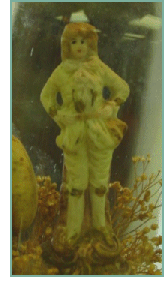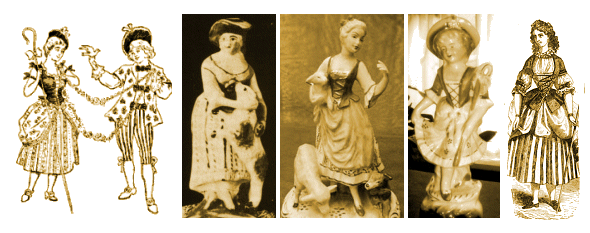china shepherdess / little china woman

 Throughout the Little House books, Ma’s precious “little china woman” represents the civilized home that Caroline Ingalls strives to create in each of her little prairie houses. It is never displayed while in temporary quarters (such as the railroad camp in By the Shores of Silver Lake or the dugout on On the Banks of Plum Creek); there is typically a ceremony involved in unpacking, admiring, and displaying of the china shepherdess prominently once the family is settled.
Throughout the Little House books, Ma’s precious “little china woman” represents the civilized home that Caroline Ingalls strives to create in each of her little prairie houses. It is never displayed while in temporary quarters (such as the railroad camp in By the Shores of Silver Lake or the dugout on On the Banks of Plum Creek); there is typically a ceremony involved in unpacking, admiring, and displaying of the china shepherdess prominently once the family is settled.
 There is no mention of a china woman / shepherdess in the handwritten Pioneer Girl manuscript or the three versions edited by Rose Wilder Lane. In the existing handwritten manuscript for Little House in the Big Woods, the “Christmas” chapter is heavily edited, with several typed insertions. Here, as in the published version, the figurine is described only as a “little china woman,” not a shepherdess. There was no description of the china woman in the manuscript; she merely existed.
There is no mention of a china woman / shepherdess in the handwritten Pioneer Girl manuscript or the three versions edited by Rose Wilder Lane. In the existing handwritten manuscript for Little House in the Big Woods, the “Christmas” chapter is heavily edited, with several typed insertions. Here, as in the published version, the figurine is described only as a “little china woman,” not a shepherdess. There was no description of the china woman in the manuscript; she merely existed.
While working on the manuscript for On the Banks of Plum Creek, Rose Wilder Lane must have asked her mother how the figurine had been described in earlier books. Laura wrote to Rose in July 1936 and included a transcription of the description from Little House in the Big Woods, Chapter 4; the text included in Laura Ingalls Wilder’s letter is shown at left in Laura’s handwriting.
Since so much of the original text about the china shepherdess in the Little House books seems to be Rose’s additions to the manuscripts, it is possible that a shepherdess was a memory of Rose’s, not Laura’s, and that it was added to the series for interest. There are far fewer mentions of the shepherdess in manuscripts than in the published Little House series.
“Sister Carrie has the shepherdess…”
In a letter to fans, Laura Ingalls Wilder once wrote that her sister Carrie “had the shepherdess.” A small figurine was found among Carrie Ingalls Swanzey’s possessions in Keystone, South Dakota, and is currently on display at the Keystone Historical Museum. Many believe that this figurine is “the prototype for the cherished china figurine” (see William Anderson’s Laura Ingalls Wilder Country, New York: HarperPerennial, 1990). The museum piece is shown in the photograph above right, yet it appears to be of a shepherd, not a shepherdess, although it could have been part of a pair of figurines. Although similar in looks to Staffordshire figures of the nineteenth century, the origin and composition of this museum piece remains unknown, nor if the piece has any markings which might help to identify it.
Too fine and delicate for the outside world…
 The shepherd and shepherdess have been immortalized in painting and sculpture for hundreds of years. The china shepherdess figurine is also prominent in literature of the nineteenth century, often found on fictional mantels and compared in looks to the beauty of a female character. Such a china shepherdess was said to be too fine and delicate for the outside world and properly enjoyed only in the parlor, snug and cosy and preferably with the door shut.
The shepherd and shepherdess have been immortalized in painting and sculpture for hundreds of years. The china shepherdess figurine is also prominent in literature of the nineteenth century, often found on fictional mantels and compared in looks to the beauty of a female character. Such a china shepherdess was said to be too fine and delicate for the outside world and properly enjoyed only in the parlor, snug and cosy and preferably with the door shut.
While fine porcelain mantel figurines were once owned only by the wealthy, there were many factories employing hundreds of craftsmen to produce both fine and cheaper imitations following the Revolutionary War, when goods began to be exported freely to America. Mantel-piece pairs of shepherd and shepherdess (or other small figures) were wildly popular in the eighteenth and nineteenth century, and enjoyed by all classes. They were a portable touch of refinement, yet by their very nature as being breakable, the special care and placement given to such items further elevated their status. Laura Ingalls Wilder wrote that no one but Ma was allowed to touch her china shepherdess, and, in the manuscript for On the Banks of Plum Creek, that “the shepherdess had traveled too far to be broken now.”
 Little House china shepherdesses.
Little House china shepherdesses.
There have been at least seven different “china shepherdess” figurines sold by the various Laura Ingalls Wilder heritage homesite gift shops over the years. In the group shown here (L-R), there are: (1) an early Laura Ingalls Wilder Memorial Society (De Smet) figurine based on the one used in the popular “Little House on the Prairie” television show; (2) one designed in 1996 by Missouri artist Cheryl Harness for the Laura Ingalls Wilder / Rose Wilder Lane Home & Museum in Mansfield, Missouri; (3) the De Smet 1990s shepherdess which includes gold accents as described by Laura Ingalls Wilder; and (4) the most recent shepherdess from the Laura Ingalls Wilder site in Walnut Grove, again based on the one used in the television show.
The photo below includes china shepherdesses from both the Independence (second from right) and Mansfield (second from left) museums, as well as two De Smet museum figurines with variations in hair color. The archives of the Laura Ingalls Wilder Museum in De Smet has at least three molds from which their shepherdesses were made over the years; they were given to the museum upon the retirement of the local craftsperson who made them for the Society.


China shepherdess (LHP 9-10; BPC 17, 37-38; SSL 8, 28-30; LTP 2; THGY 19)
little china woman (BW 4)

